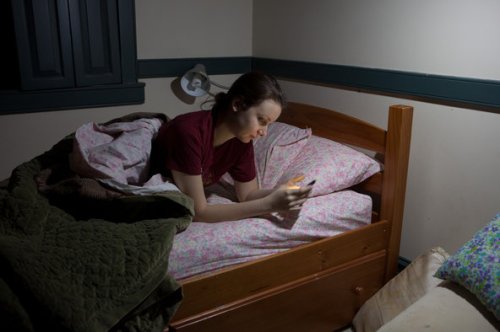Larry Cuban on School Reform and Classroom Practice: Politics, Research, and School Reform: Letting Teens Sleep in
Teaching high school students, first period of the school day, say, 7:30 or 8 AM is tough. Why? Students from both affluent and working class families shuffle into the room, sometimes carrying wake-up food and drink, and sit down at their desks giving the teacher the 1000-yard stare or closing their glazed eyes. They are sleepy.
Recent research (see here, here and here) has established that adolescent bodies and minds are still developing and getting five or less hours of sleep a night when doctors recommend nine means sluggish lessons in the mornings and sleepy afternoons in class.
Citing such research, some school boards (e.g., Long Beach, California; Glen Falls, New York, and Stillwater, Oklahoma), after many open meetings with parents and experts on sleep and teenagers initiated later start times for middle and high school students. Research tied to solving a problem–sleepy and non-involved teenagers in academic classes– supporting a tidy solution such as a later school starting time in morning–seemed, thus far, to work in these communities. However, in other communities, raw politics, and coalitions built by sleep-deprived teenagers allied with parents and teachers made the changes.
Consider 17 year-old Jilly Dos Santos who tries again and again to get to her 7:50 AM class on time at Rock Bridge High School in Columbia (MO). And failed. She is an academically strong student, works at a fast food restaurant after school and interned in a get-out-the-voter campaign earlier in the year. She heard that the school board was meeting in a few weeks to approve a half-hour earlier starting time. Yes, 7:20 AM. Santos, a sleep-deprived teenagers morphed into a political “sleep activist.”
Santos created a Facebook page and Twitter account telling hundreds of fellow students that the school board was going to start school at 7:20 AM. She contacted a non-profit group about sleep that gave her the scientific studies about how teenagers needed more, not less, sleep. She emailed all teachers in the district and started an online petition. She brought other students together and they made posters. She tweeted everyone that “If you are going to be attending the board meeting tomorrow we recommend you dress up.”
You guessed it. The school board turned down the earlier start time. A few months later, the coalition that Santos had pulled together worked successfully to get the school board to start high school at 9 AM. The superintendent said after the board voted 6-1 in favor of the later time: “Jilly kicked it over the edge for us.”
Who said that schools are apolitical institutions?
I use the example of Santos to underscore how an issue as school start times, so often driven by efficiency–scheduling a limited number of buses for both elementary and secondary schools, when teachers have to be in their classrooms in the morning, parents’ demands for child care, and other factors–gets turned around when a group of teenagers, teachers, and parents coalesce into a political group pressing the school board to alter its policy. Rowdy democracy in action.
So here is an incontrovertible fact: schools are political institutions. This fact means that teachers, principals, superintendents, students, and parents are political actors also. Not in the partisan sense of Democrats and Republicans but in the fundamental sense that politics are about relationships over power, resources, and to achieve goals.
Of course, reformers in every generation have known that schools are political institutions subject to popular pressures to adopt or reject policies. With the state and federal centralization of authority for school policies over the past half-century–think No Child Left Behind, state charter school laws, and Common Core Standards–the political nature of schooling becomes self-evident. Although the word “politics” continues to have a sour smell about it to many parents, teachers, principals, and superintendents, for Jilly Dos Santos, the fragrance of politicking the school board to adopt a later start time drove her on. She and like-minded citizens practiced democratic action.
Here is the second fact about the role research studies played into the political success of the coalition that Santos’s mobilized in favor of a later start time. As much as each of us believes that data compiled into evidence, especially from scientific studies, are essential to get a policy adopted–after all we see ourselves as rational and mindful creatures–in this instance of having teenagers come to school later in the morning–research studies became useful but clearly subordinate tools. Without the political muscle of the coalition Santos and others mobilized, ho-hum responses from the school board would have occurred.
Political muscle at the federal, state, and local levels, using research as a shield and lance, continues to dominate the current reform debate over what teachers should teach, how they should teach, choice in schools, and, yes, what time Jilly Dos Santos has to wake up and go to Rock Bridge High School tomorrow morning.
This blog post has been shared by permission from the author.
Readers wishing to comment on the content are encouraged to do so via the link to the original post.
Find the original post here:
The views expressed by the blogger are not necessarily those of NEPC.

